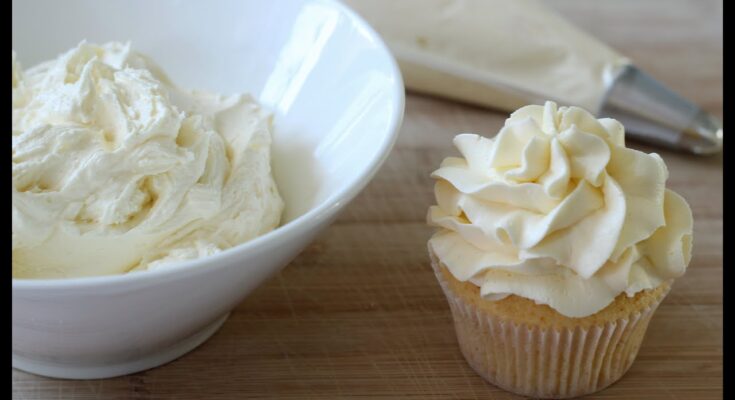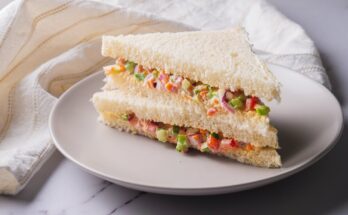Powdered Sugar Icing Recipe: Powdered sugar icing—also known as glaze icing—is one of the simplest, yet most versatile toppings in the baking world. It takes mere minutes to make, requires only a handful of ingredients, and elevates just about any dessert with a glossy, sweet finish. From classic sugar cookies to bundt cakes and cinnamon rolls, this icing brings everything together with a deliciously smooth, melt-in-your-mouth layer of sweetness.
But don’t let its simplicity fool you. There’s a finesse to getting it just right—balancing consistency, adjusting flavor, and knowing exactly how to apply it. Whether you’re a beginner in the kitchen or a seasoned baker looking for a quick fix, powdered sugar icing is your go-to solution.
Let’s dive into the details to ensure your icing turns out perfectly every time.
Ingredients Needed
Here’s the best part: powdered sugar icing only needs two core ingredients.
Basic Ingredients:
- Powdered sugar (confectioners’ sugar): This ultra-fine sugar gives the icing its signature smooth texture. Regular granulated sugar won’t work here—it’s not fine enough and will leave your icing gritty.
- Liquid (milk, water, or cream): A little goes a long way. You’ll be surprised how just a tablespoon or two can transform a bowl of powdered sugar into silky icing.
Optional Add-ins:
- Vanilla extract: For a classic flavor twist.
- Almond or lemon extract: Adds a unique zing.
- Butter: Creates a richer texture and taste.
- Salt: Just a pinch can balance the sweetness.
That’s it. With just these pantry staples, you’re ready to whip up a batch of icing that’ll have your desserts looking bakery-worthy in no time.
Tools You’ll Need
You don’t need fancy kitchen gadgets to make powdered sugar icing, but having the right tools on hand will make the process smoother.
Essential Tools:
- Mixing bowl: Medium-sized is usually enough.
- Whisk or fork: Helps dissolve the sugar and create a smooth consistency.
- Measuring spoons: To control the amount of liquid.
- Fine mesh strainer (optional): Ideal for sifting the powdered sugar and avoiding lumps.
Optional Tools:
- Piping bag or squeeze bottle: Great for decorating cookies or precision icing.
- Spatula or spoon: For spreading the icing over baked goods.
- Dropper or teaspoon: Perfect for adding extracts or food coloring without overdoing it.
These everyday tools ensure your icing mixes easily, applies smoothly, and looks professionally made.
Step-by-Step Instructions
Now that you’ve gathered your ingredients and tools, it’s time to make the magic happen. Here’s a foolproof guide to crafting smooth, creamy powdered sugar icing in just minutes.
Step 1: Sift the Powdered Sugar
Before mixing, sift your powdered sugar to eliminate any lumps. This step might seem minor, but it makes a big difference. Lumps can mess with your icing’s texture and appearance—sifting ensures a velvety smooth finish.
Step 2: Add the Liquid Slowly
Pour in your liquid of choice (milk, water, or cream), but start slowly—about one tablespoon per cup of powdered sugar. Stir it in with a whisk or fork. At first, it might look like there’s not enough liquid, but keep stirring and it’ll begin to loosen up into a smooth glaze.
Step 3: Adjust the Consistency
Depending on your needs, you can tweak the icing:
- For drizzling: A thinner consistency is best. Add a few more drops of liquid.
- For spreading: You’ll want it a little thicker so it holds its shape.
- For dipping: Medium consistency is ideal—fluid, but not runny.
Add liquid just a teaspoon at a time until you hit the sweet spot.
Step 4: Add Flavor or Color (Optional)
If you want to jazz up your icing, now’s the time. Add a splash of vanilla extract or your favorite flavor. To color it, mix in a few drops of food coloring—gel-based works best for vibrant hues without watering down the icing.
Once you’ve hit the perfect texture and flavor, it’s ready to go! Use immediately for best results, as powdered sugar icing tends to crust over as it sits.
Consistency Tips
When it comes to powdered sugar icing, getting the right consistency is everything. Too runny and it will slide off your treats. Too thick and it’ll be impossible to spread or drizzle smoothly. So, how do you find that perfect middle ground? Let’s break it down.
For Thin, Drippy Icing: This is perfect for drizzling over cakes, bundt cakes, or cookies when you want that slightly transparent, glossy glaze.
- Start with 1 cup of powdered sugar and 1 tablespoon of liquid.
- Add more liquid a teaspoon at a time until you reach a runny, pourable consistency.
- Tip: Use a spoon to drizzle it back into the bowl—it should form a ribbon that disappears in a few seconds.
For Thick, Spreadable Icing: Great for covering sugar cookies or cinnamon rolls with a smooth coat that holds its shape but still softens as it dries.
- Start with less liquid—maybe just a teaspoon per cup of sugar.
- Add tiny amounts of liquid until it’s thick but still spreadable with a spoon or spatula.
How to Fix Mistakes:
- Too thick? Add a drop or two of milk or water. Stir well before adding more.
- Too thin? Add a spoonful of powdered sugar, then mix again.
- Too lumpy? Try whisking more vigorously, or strain it through a fine sieve.
Icing consistency can vary with humidity and ingredient temperature, so always make small adjustments and test as you go.
Flavor Variations
Basic powdered sugar icing is sweet and simple, but sometimes, you want a little extra punch. The good news? You can easily customize your icing to suit any dessert or flavor profile.
1. Classic Vanilla Icing:
- Add 1/2 teaspoon of pure vanilla extract per cup of powdered sugar.
- This version pairs well with almost any baked good.
2. Zesty Lemon Icing:
- Replace milk with fresh lemon juice for a bright, tangy flavor.
- Add a pinch of lemon zest for even more citrus goodness—perfect for pound cakes or scones.
3. Chocolate Powdered Sugar Icing:
- Mix 1 tablespoon of unsweetened cocoa powder with your powdered sugar before adding liquid.
- Use milk or cream for a richer chocolate glaze.
4. Almond or Peppermint:
- A few drops of almond extract can completely change the flavor profile—great for holiday cookies.
- Peppermint extract is bold, so start with 1/8 teaspoon and adjust to taste.
Remember: extracts are concentrated, so add a little at a time. Mix, taste, and tweak until it’s just right.
How to Color Powdered Sugar Icing
Adding color to your powdered sugar icing is a fun way to match themes, holidays, or just make your desserts pop. Here’s how to do it without ruining your perfect consistency.
Types of Food Coloring:
- Gel Food Coloring: Best choice. Highly pigmented, won’t thin out the icing.
- Liquid Food Coloring: Works fine, but may water down the icing—adjust sugar if needed.
- Powdered Coloring: Rare, but offers vibrant results without affecting texture.
Steps to Color:
- Mix your icing first until it’s the perfect consistency.
- Add a small amount of color using a toothpick or dropper.
- Stir well to fully incorporate the color.
- Continue adding until desired shade is reached.
Pro Tips:
- Color deepens slightly as it sits—especially reds and blacks.
- For multiple colors, divide the icing into bowls and tint each one separately.
- Use gloves if working with intense colors to avoid stained fingers.
Colorful icing not only enhances presentation but also brings out the creativity in baking. Whether it’s pastel pink for a baby shower or vivid green for St. Patrick’s Day cookies, the possibilities are endless.
Best Uses for Powdered Sugar Icing
Powdered sugar icing isn’t just limited to cookies. Its versatile texture and mild sweetness make it the ideal finishing touch for a wide range of desserts. Here’s where it really shines:
1. Sugar Cookies: The most classic pairing. Use slightly thick icing to “flood” the surface of cookies. Let it harden for a smooth, glossy finish.
2. Cinnamon Rolls: A warm cinnamon roll slathered in silky icing is a breakfast dream. Thin the icing slightly so it melts over the rolls while they’re still hot.
3. Bundt Cakes and Pound Cakes: A drizzle of glaze gives these dense cakes a professional look and an extra hit of sweetness. Add lemon or almond extract for a fancy twist.
4. Donuts: Dip freshly fried donuts into a bowl of icing, then let them set. You can even add sprinkles or chopped nuts while the glaze is wet.
5. Muffins and Scones: A zigzag drizzle over the top gives bakery vibes in seconds.
6. Quick Breads (like banana or zucchini): The glaze adds visual appeal and balances out the dense texture.
This icing enhances both flavor and appearance, turning simple treats into showstoppers.
Storing and Reusing Icing
You’ve made a perfect batch of powdered sugar icing, but you’ve got leftovers. Don’t toss it—save it for later!
Storage Tips:
- Store in an airtight container at room temperature for up to 2 days.
- For longer storage, keep it in the fridge for up to a week.
- Stir well before using again. You may need to add a few drops of milk or water to loosen it.
Freezing:
- You can freeze powdered sugar icing, but note that it may need re-whipping after thawing to bring back smoothness.
- Store in a freezer-safe bag or container for up to 3 months.
Pro Tip:
- Label your container with the date and any flavors or colors used, so you don’t forget what’s inside.
Leftover icing is super handy when you want to quickly dress up a batch of cookies or cupcakes. Just give it a quick stir, adjust if needed, and you’re good to go!
Troubleshooting Common Issues
Even though powdered sugar icing is incredibly simple, it doesn’t always go perfectly. If your icing isn’t turning out quite right, don’t worry—we’ve got fixes for the most common problems.
Problem 1: Icing Is Too Runny
This usually happens if you added too much liquid too quickly.
Fix:
- Stir in extra powdered sugar, one tablespoon at a time.
- Mix thoroughly until the consistency is thicker and spreads or drizzles as needed.
Problem 2: Icing Is Too Thick
Maybe you were too conservative with the liquid, or your powdered sugar was extra dry.
Fix:
- Add liquid one teaspoon at a time.
- Stir after each addition until it’s smooth and workable.
Problem 3: Lumpy Icing
This is often caused by not sifting the powdered sugar or not mixing well enough.
Fix:
- Sift the powdered sugar before mixing.
- Use a whisk instead of a spoon for smoother results.
- If lumps persist, press the icing through a fine mesh sieve.
Problem 4: Icing Crusts Too Quickly
Powdered sugar icing tends to harden on the surface when exposed to air.
Fix:
- Cover it with plastic wrap directly touching the surface when not using.
- If it begins to harden, stir in a drop of water and mix well.
Problem 5: Dull Finish
If your glaze looks cloudy or grainy, the sugar may not be fully dissolved.
Fix:
- Use room temperature liquid to help the sugar dissolve more efficiently.
- Mix until the glaze is shiny and smooth.
Troubleshooting ensures your icing not only looks good but also spreads like a dream and dries to a perfect finish.
Powdered Sugar Icing vs Royal Icing
Powdered sugar icing and royal icing are often confused, but they serve very different purposes in the baking world. Here’s a side-by-side comparison to help you understand when to use each.
| Feature | Powdered Sugar Icing | Royal Icing |
|---|---|---|
| Base Ingredients | Powdered sugar + liquid | Powdered sugar + egg whites or meringue powder |
| Consistency | Soft, glaze-like | Stiff, pipeable |
| Hardness When Dry | Semi-soft, slightly crusty | Hard and crisp |
| Drying Time | 30 minutes to 1 hour | Several hours to overnight |
| Best For | Drizzling, glazing | Intricate cookie decorations |
| Flavor | Sweeter, simpler | Slightly more complex |
| Shelf Life | Short | Long-lasting when dry |
When to Use Powdered Sugar Icing:
- When you need something quick and easy.
- For topping cakes, muffins, cinnamon rolls, and donuts.
When to Use Royal Icing:
- When decorating cookies with detailed designs.
- When you need the icing to harden completely for stacking or packaging.
Understanding the difference helps you choose the right icing for the job every time.
Expert Tips for Perfect Icing Every Time
Want your powdered sugar icing to look like it came from a professional bakery? These tips will take your icing game to the next level:
1. Sift Always, Mix Gently
Start by sifting your powdered sugar. It might feel like an extra step, but it ensures your icing is ultra-smooth. When mixing, don’t over-whisk—just enough to combine all the ingredients evenly.
2. Flavor First, Color Later
If you’re adding flavor and color, do flavor first. Some extracts can slightly alter the texture or tint of the icing, so always mix those in before adjusting color.
3. Use Room Temperature Ingredients
Cold milk or butter can cause the sugar to clump or not dissolve fully. Keep everything at room temperature for best results.
4. Use a Squeeze Bottle for Precision
Want clean lines or stripes on cookies or donuts? Transfer your icing to a clean squeeze bottle for better control.
5. Clean As You Go
This icing dries fast. Wipe your utensils, bowls, and counters immediately after use to avoid crusty sugar cleanup later.
6. Test on a Plate First
Before icing your actual dessert, test the consistency and color on a small plate. It’s a great way to make sure you’re happy with the final result.
7. Avoid Humid Days
Humidity can affect drying time and cause your icing to remain sticky longer than usual. If you’re decorating for an event, try to make the icing on a dry day for best results.
Following these pro tips can make even a quick glaze look like an artisanal topping.
FAQs about Sugar Icing Recipe
1. Can I make powdered sugar icing ahead of time?
Yes! Store it in an airtight container at room temperature for a day or refrigerate it for up to a week. Just stir well before using again.
2. Can I freeze powdered sugar icing?
Absolutely. Freeze in an airtight container for up to 3 months. Thaw in the fridge and re-whip before using.
3. How do I make powdered sugar icing dairy-free?
Use water or plant-based milk (like almond or oat milk) instead of dairy. It works just as well and is great for vegan recipes.
4. Can I use powdered sugar icing for piping?
Not really. It’s too soft for detailed piping. If you need stiff lines or decorations, go with royal icing instead.
5. Is powdered sugar icing good for gingerbread houses?
It’s okay for light decoration, but not ideal for structural parts. Use royal icing for sturdy construction.
Conclusion
Powdered sugar icing is the unsung hero of the baking world. It’s fast, easy, and endlessly customizable—whether you want a soft vanilla glaze or a zesty lemon drizzle. With just a few ingredients and a couple of minutes, you can take your baked goods from basic to bakery-level. Whether you’re glazing donuts, drizzling over a bundt cake, or decorating sugar cookies, this icing is your trusty go-to.
Now that you’ve mastered the basics—and even some pro tips—you’re ready to whip up batches of glossy, delicious icing like a seasoned pastry chef. Remember, the beauty of powdered sugar icing lies in its simplicity, and with a little practice, your desserts will be the talk of every table.



